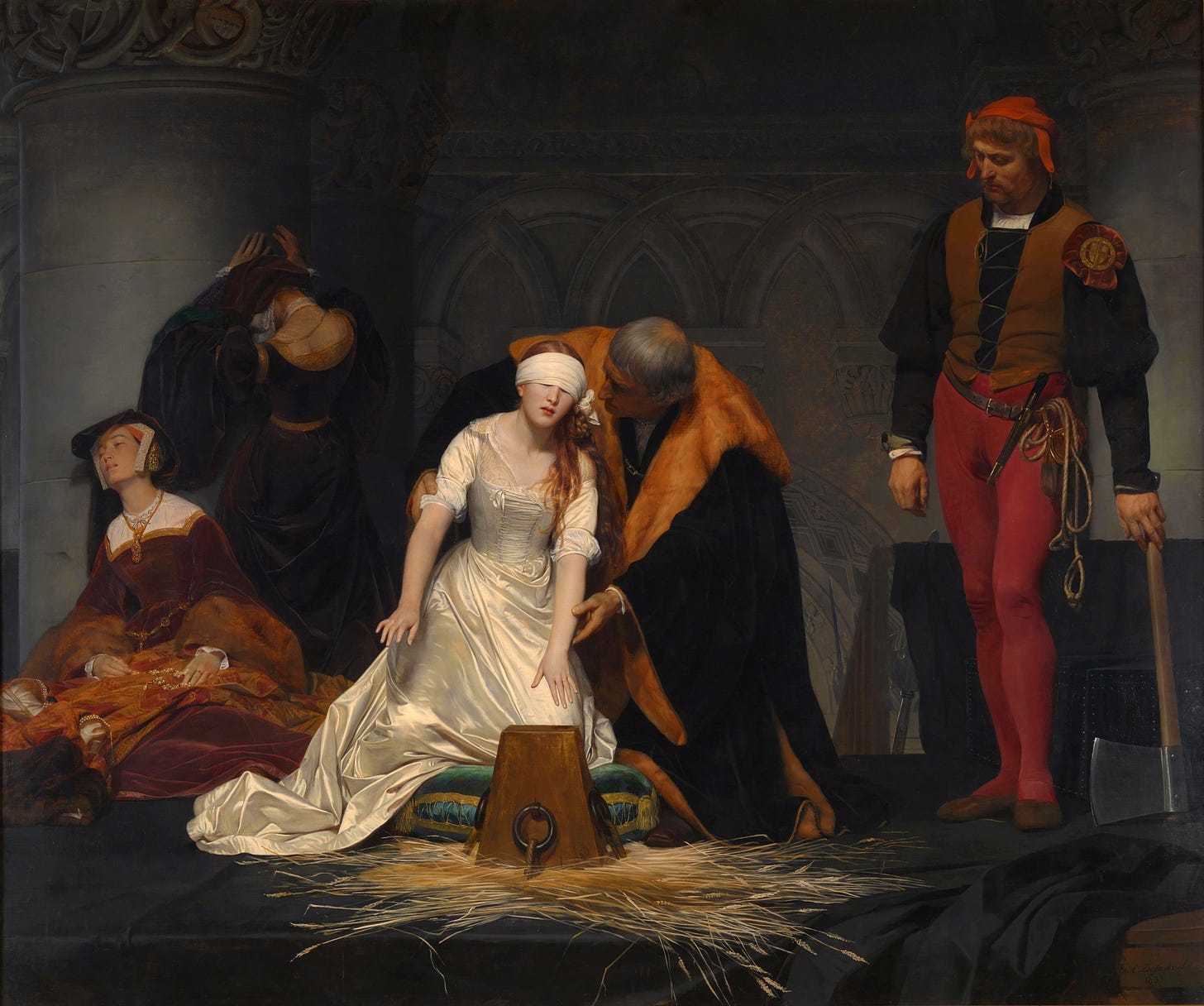Art & Artifacts
Just as I had done last semester, my Substack posts will focus on visual arts. This time, I intend to focus on art and the historical background that influenced it.
To honor TikTok in the time of it’s “ban”, let’s tackle a viral painting: Paul Delaroche’s Execution of Lady Jane Grey.
Queen Mary of England, rightfully nick-named Bloody Mary, was more than comfortable with taking any steps to secure her throne. Being a Catholic queen in times of Protestant turmoil, anyone in power with opposing beliefs was seen as an immense threat to Queen Mary. As Lady Jane Grey’s father joined a rebellion against her, she felt reason to send he, his daughter, and her husband, Lord Guilford Dudley to execution. Feeling strongly in her beliefs, Mary offered the group pardon if they converted to Catholicism. Although they knew what a no would lead to, they took that option over conversion. As individuals of power, Lady Jane and Lord Guilford were bother offered a private execution held within the Tower of London. Just an hour after her husband’s death, Lady Jane Grey was taken to the same block.
The center of the painting showcases Lady Jane in her white undergarments, the lightly colored satin representing innocence and purity. One of her ladies, the one on the floor, sits with Lady Jane’s dress draped across her lap. Being a well educated and respected monarch, Lady Jane removed her dress to avoid ruining it and creating more work for those set to care for the room after her death. The other lady leans against the wall in despair knowing what events are about to occur. The restrained, tender gestures of Lady Jane’s attendants and her blindfolded, helpless posture heighten the emotional intensity, emphasizing themes of betrayal, loss, and the tragedy of youthful innocence. Lady Jane Grey is portrayed as the luminous focal point of the painting, with her pale dress and skin contrasting against the darker, somber background, symbolizing her vulnerability and readdressing the theme of innocence.
Contrasting her under garments, Delaroche uses a pop of color for her outer wear. In art history, the color orange was used to represent signs of danger. Looking at the dress her lady is holding, it is clear the shade was used to represent that same thing. To further the symbolism in the piece, her hands are both extended to find the block, but neither hand has a ring. Lady Jane Grey entered death widowed as her husband was killed right before she was.
Transcripts of her execution make the scene portrayed much more real for the viewer as it is accurate to the actual events. The man helping her find the block would have been the lieutenant. Before her death, she handed him her prayer book and thanked him kindly. Being only 17 years of age, it was clear she was in a panic. Delaroche plays to the theme of historical drama. In actuality, Lady Jane Grey was merely a pawn. Queen Mary had plans to eliminate those who may have threatened her rule; it just happened to fall into place for her to do so “correctly”. Lady Jane is a stark difference from Queen Mary when comparing the two historically. “Bloody Mary” against the “Nine Day Queen” wasn’t exactly a fair match.
To read more on Lady Jane Grey: https://www.hrp.org.uk/tower-of-london/history-and-stories/lady-jane-grey/#gs.jqgzb3






at least she got reincarnated as one of the X-Men
This blog indeed drew me into the terrible realm of Lady Jane Grey's execution. Though I have always found Paul Delaroche's paintings intriguing, reading this study helped me view them from an entirely different perspective. The writer masterfully caught the contrast between Lady Jane's innocence and the terrible reality of her death. I felt her helplessness, especially in how they characterized her white undergarments as emblems of purity and fragility against the dark, repressive background. In that dark, weighty room where every feature seemed to reflect her approaching death, I could practically see myself. This review indeed increased my respect for Delaroche's work. It made me consider art's ability to help us relate to historical events and individuals. Although Lady Jane's narrative is centuries old, this study made it seem instantaneous and intimate as I stood in that room with her. Now, considering all these elements, I will go back over the painting and know I will never see it the same way again.